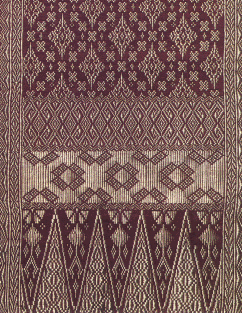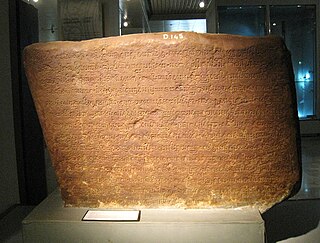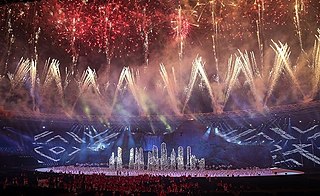
Palembang is the capital city of the Indonesian province of South Sumatra. The city proper covers 352.51 square kilometres on both banks of the Musi River in the eastern lowlands of southern Sumatra. It had a population of 1,668,848 at the 2020 Census; the official estimate as at mid 2023 was 1,772,492. Palembang is the second most populous city in Sumatra, after Medan, and the twelfth most populous city in Indonesia.

Indonesia is a country with many different tribes and ethnic groups, and its music is also very diverse, coming in hundreds of different forms and styles. Every region has its own culture and art, and as a result traditional music from area to area also uniquely differs from one another. For example, each traditional type of music is often accompanied by its very own dance and theatre. Contemporary music scene have also been heavily shaped by various foreign influences, such as America, Britain, Japan, Korea, and India.

Srivijaya, also spelled Sri Vijaya, was a Hindu-Buddhist thalassocratic empire based on the island of Sumatra that influenced much of Southeast Asia. Srivijaya was an important centre for the expansion of Buddhism from the 7th to 11th century AD. Srivijaya was the first polity to dominate much of western Maritime Southeast Asia. Due to its location, Srivijaya developed complex technology utilizing maritime resources. In addition, its economy became progressively reliant on the booming trade in the region, thus transforming it into a prestige goods-based economy.

South Sumatra is a province of Indonesia, located in the southeast of the island of Sumatra. The capital and largest city of the province is the city of Palembang. The province borders the provinces of Jambi to the north, Bengkulu to the west and Lampung to the south, as well a maritime border with the Bangka Belitung Islands to the east. It is the largest province in the island of Sumatra, and it is slightly smaller than Portugal, the department of Boquerón in Paraguay or the U.S. state of Maine. The Bangka Strait in the east separates South Sumatra and the island of Bangka, which is part of the Bangka Belitung Islands province. The province has an area of 91,592.43 km2 (35,364 sq mi) and had a population of 8,467,432 at the 2020 census; the official estimate as at mid-2023 was 8,743,522. The province is rich in natural resources, such as petroleum, natural gas and coal. The province is inhabited by many different Malay sub ethnic groups, with Palembangese being largest ethnic group. Most speak the Palembang language, which is mutually intelligible to both Indonesian and local Palembang Malay. Other ethnic groups include the Javanese, Sundanese, Minangkabau and Chinese. Most are concentrated in urban areas and are largely immigrants from other parts of Indonesia.

Betel nut chewing, also called betel quid chewing or areca nut chewing, is a practice in which areca nuts are chewed together with slaked lime and betel leaves for their stimulant and narcotic effects, the primary psychoactive compound being arecoline. The practice is widespread in Southeast Asia, Micronesia, Island Melanesia, and South Asia. It is also found among both Han Chinese immigrants and indigenous peoples of Taiwan, Madagascar, and parts of southern China. It was introduced to the Caribbean in colonial times.

The culture of Indonesia has been shaped by the interplay of indigenous customs and diverse foreign influences. With over 600 distinct ethnic groups, including significant Austronesian and Melanesian cultures, contributing to its rich traditions, languages, and customs, Indonesia is a melting pot of diversity. Positioned along ancient trade routes between the Far East, South Asia, and the Middle East, the country has absorbed cultural practices influenced by Hinduism, Buddhism, Confucianism, Islam, and Christianity. These influences have created a complex cultural tapestry that often differs from the original indigenous cultures.

Zapin is one of the most popular dance and musical forms in traditional Malay performing arts. Dance movements are choreographed to melodies, which are performed using musical instruments such as the gambus, accordion, and rebana. It is believed to have been introduced by Persian and Arab Muslim missionaries from the Middle East to the Malay Archipelago around the fourteenth century, where back then only males were allowed to perform; nowadays, female dancers are included. It used to be performed exclusively for religious ceremonies but through the years it has become a form of traditional entertainment, hence the participation of female dancers is allowed.

The 2011 Southeast Asian Games, officially known as the 26th Southeast Asian Games, or the 26th SEA Games, and commonly known as Jakarta-Palembang 2011, was a Southeast Asian multi-sport event held from 11 to 22 November 2011 in Jakarta and Palembang, Indonesia. It was Indonesia's fourth time to host the Southeast Asian Games, and its first since 1997. Previously, Indonesia also hosted in 1979 and 1987. The capital city of Jakarta hosted all three of the previous Games prior to this. Palembang became the third SEA Games non-capital host city, after Chiang Mai (1995) and Nakhon Ratchasima (2007), both in Thailand. Around 5,965 athletes from 11 participating nations participated at the games which featured 545 events in 44 sports. The biggest competitor, sports, and events in Southeast Asian Games history.

Gelora Sriwijaya Stadium, also known as Jakabaring Stadium, is a multi-purpose stadium located in Jakabaring Sport City complex in Palembang, South Sumatra, Indonesia. Holding 23,000 spectators., the stadium is currently used mostly for football matches. The construction began in 2001 and finished in 2004 to host the 2004 Indonesia National Games. The stadium was initially named as Jakabaring stadium after the location of the stadium in southern outskirt of Palembang. However, later the stadium was renamed "Gelora Sriwijaya", to honor and celebrate the 7th—13th century Indonesian empire of Srivijaya. The Third Place Playoff of the 2007 AFC Asian Cup was held in this stadium. The football club Sriwijaya is based at the stadium.

Songket or sungkit is a tenun fabric that belongs to the brocade family of textiles of Brunei, Indonesia, and Malaysia. It is hand-woven in silk or cotton, and intricately patterned with gold or silver threads. The metallic threads stand out against the background cloth to create a shimmering effect. In the weaving process the metallic threads are inserted in between the silk or cotton weft (latitudinal) threads in a technique called supplementary weft weaving technique.

The Melayu Kingdom was a classical Buddhist kingdom located in what is now the Indonesian province of West Sumatra and Jambi.

Dance in Indonesia reflects the country's diversity of ethnicities and cultures. There are more than 600 ethnic groups in Indonesia. Austronesian roots and Melanesian tribal forms are visible, and influences ranging from neighboring Asian and even western styles through colonization. Each ethnic group has its own dances: there are more than 3,000 original dance forms in Indonesia. The old traditions of dance and drama are being preserved in the numerous dance schools which flourish not only in the courts but also in the modern, government-run or supervised art academies.

Bukit Seguntang or Bukit Siguntang is a 29–30 metres high small hill located at the northern bank of Musi River and within the vicinity of Palembang, capital city of South Sumatra, Indonesia. It is located around 3 kilometres north from Musi River northern bank and around four kilometres southwest from Palembang city center. The place is considered sacred by the locals and home of many archeological relics believed to be related to Srivijaya Empire, once a dominating political power around Malacca Strait. Today the hill gain status as an archaeological park.

Tanggai dance is an Indonesian traditional dance performed to welcome people in the weddings. Tanggai dance is Palembangnese traditional dance performed to welcome honorable guests and people in formal events or weddings. In 1965, Tanggai dance was created by Mrs. Elly Rudy (76), the South Sumatran Dance Maestro and the Indonesian Dance Legend, after the banning of Gending Sriwijaya Dance and Dong, the Welcome Dance which also uses long finger nails and carries a small wooden box, for political reasons. In 1965, in Jakarta, on the initiative of the late Raden Husin Natodirajo and Mgs. Nungcik Asaari, both were the two famous Palembang cultural figures, Mrs. Elly Rudy created Tanggai Dance carrying tepak and wearing tanggai. This dance is also functioned as the Welcome Dance to welcome the arrival of noble guests who came to visit Palembang. This has been reinforced by the late Palembang cultural observer R. Johan Hanafiah. So, Mrs. Elly Rudy created a dance entitled Tari Tanggai using the song "Enam Saudara". The dance is practiced in Palembang.

Balaputradeva Museum, officially the State Museum of South Sumatra Province "Balaputradeva", is an ethnographic museum located in Southern Sumatra's capital Palembang. The museum is the state museum of the Province of South Sumatra. The name Balaputradeva is derived from Balaputra, a 9th century sovereign of Srivijaya kingdom and the former head of the Sailendra dynasty whose main center was located in the vicinity of Palembang. Balaputradeva Museum displays the history and traditions of the province of South Sumatra.

The opening ceremony of the 2018 Asian Games took place on Saturday, 18 August 2018, at the Gelora Bung Karno Main Stadium in Jakarta, Indonesia. The event commenced at 19:00 Indonesia Western Time (UTC+7) and ended at 21:25 local time. Wishnutama Kusubandio was the creative director of the ceremony. The ceremony featured a stage designed as a 26-meter-high mountain with a waterfall. It weighed 600 tons, was 120 meters long and 30 meters wide, and included a display of Indonesian plants and flowers, as well as a mock volcano. The volcano symbolized Indonesia's location in the "Ring of Fire" surrounding the Pacific Ocean. Host event broadcasting company International Games Broadcast Services (IGBS) filmed the televised coverage of the ceremony live internationally.

Baksa Kembang is one of the classical Banjar dances originating from South Kalimantan, Indonesia, which functions as a welcoming dance for guests. This dance is usually played by female dancers with the condition that the number of dancers must be odd.

Melinting is one of the traditional Lampungese dances originating from the Lampung province, Indonesia. The Melinting dance was originally called the Cetik Kipas dance. The name was later replaced with the Melinting dance which refers to the origin of this dance, namely the Melinting area. The name change was at the suggestion of President Sukarno who asked the Central Lampung Regional Government to perform the dance at Istora Senayan Jakarta on August 17, 1965. Melinting is a dance inherited from Ratu Melinting which is estimated to have existed in the sixteenth century. This dance is performed at traditional events when welcoming guests, and the dancers are members of the Queen's family or Melinting nobles. This dance was danced outside a traditional event for the first time in 1930 in Teluk Betung at the invitation of the Resident of Lampung to Pesirah Marga in Lampung.

Kebagh dance, formerly known as the Semban Bidodari, is a traditional Palembang dance originating in Pagaralam, South Sumatra, Indonesia. This dance is characterized by the movement of opening both hands, such as spreading wings, and is usually performed to welcome distinguished guests in traditional ceremonies.


























